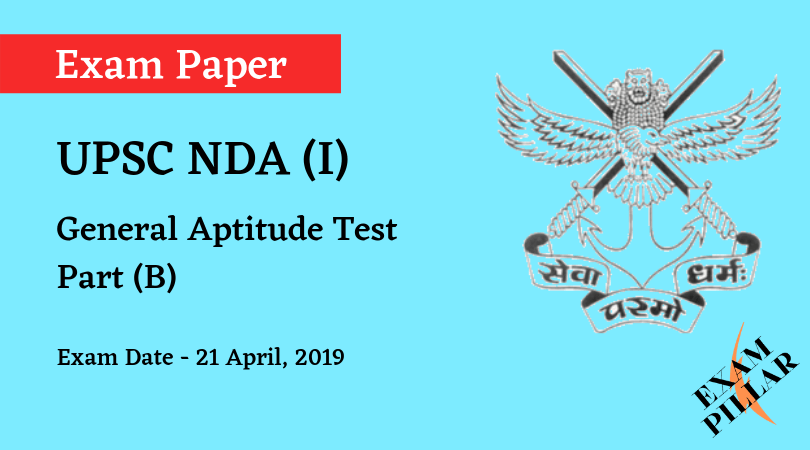131. Who among the following historians have described the Quit India movement as a ‘spontaneous revolution’?
(a) Gordon Johnson
(b) David Arnold
(C) F G Hutchins
(d) Peter Robb
Click here to Show Answer/Hide
The following 3 (three) items consist of two statements, Statement I and Statement II. Examine these two statements carefully and select the correct answer using the code given below:
Code :
(a) Both the statements are individually true and Statement II is the correct explanation of Statement I
(b) Both the statements are indivi dually true and Statement II is NOT the correct explanation of Statement I
(c) Statement I is true but Statement II is false
(d) Statement I is false but Statement II is true
132.
Statement I : Abul Fazl shaped, represented and articulated the ideas associated with the reign of Akbar
Statement II : The qualities of Abul Fazl impressed Akbar who found the former suitable as an adviser and spokesperson for his policies
Click here to Show Answer/Hide
133.
Statement I : The Kisan manifesto adopted by the All India Kisan Sabha in August 1936 contained radical demands
Statement II : The All India Kisan Sabha was a part of the Congress and maintained close relationship with the Provincial Congress Committees
Click here to Show Answer/Hide
134.
Statement I : The British ruled India through a modern bureaucracy headed by the Indian Civil Service, whose members were recruited through merit based on open competition
Statement II : The Indian Civil Service was based on the whole hearted participation of Indians
Click here to Show Answer/Hide
135. Which one of the following is NOT true in reference to Air mass ?
(a) Air mass forms either in tropical or in polar region
(b) Air mass develops on continents as well as over ocean
(c) Air mass develops in a cyclonic condition
(d) Air mass changes the weather conditions
Click here to Show Answer/Hide
136. National Water Academy, a centre of excellence in training and capacity building in water resource, is located at
(a) New Delhi
(b) Kolkata
(c) Pune
(d) Chennai
Click here to Show Answer/Hide
137. “Campos” and “Llanos”, Tropical Savanna grasslands are generally found in
(a) Australia
(b) Central Africa
(c) South America
(d) East Asia
Click here to Show Answer/Hide
138. “Viticulture” is a common feature of which one of the following Australian cities?
(a) Adelaide
(b) Darwin
(c) Hobart
(d) Brisbane
Click here to Show Answer/Hide
139. “Shamal” warm and dry wind is a “Local” wind found in
(a) East Asia
(b) West Coast of Africa
(c) Sahara of Africa
(d) Mesopotamia
Click here to Show Answer/Hide
140. “Inversion of Rainfall” is associated with
(a) Orographic rainfall
(b) Convectional rainfall
(c) Cyclonic rainfall (Tropical)
(d) Cyclonic rainfall (Temperate)
Click here to Show Answer/Hide
141. Who was the author of the book ‘History of British India’?
(a) Charles Grant
(b) John Stuart Mill
(c) James Mill
(d) William Jones
Click here to Show Answer/Hide
142. The Azamgarh Proclamation of August 25, 1857 stressed on which one of the following issues ?
(a) Hindu-Muslim divide
(b) Support to the English Government
(c) The return of the Badshahi
(d) The imposition of heavy Jumas (revenue demand)
Click here to Show Answer/Hide
143. Which Viceroy had made the observation, “It’s a beautiful world if it wasn’t for Gandhi ……..” ?
(a) Lord Irwin
(b) Lord Wavell
(c) Lord Mountbatten
(d) Lord Willingdon
Click here to Show Answer/Hide
144. Which Indian businessman favoured ‘healthy capitalism’ in helping Gandhiji to work towards a ‘common object’?
(a) Ghanshyam Das Birla
(b) Ambalal Sarabhai
(c) Sir Biren Mookerjee
(d) T. T. K. Krishnamachari
Click here to Show Answer/Hide
145. The art piece “In Memoriam” was a creation of which one of the following European painters?
(a) Thomas Jones Barker
(b) Joseph Noel Paton
(c) Thomas Daniell
(d) Charles D’Oyly
Click here to Show Answer/Hide
146. Which one of the following can charge an insulator?
(a) Current electricity
(b) Static electricity
(c) Magnetic field
(d) Gravitational field
Click here to Show Answer/Hide
147. At 20°C, the speed of sound in water is approximately
(a) 330 m/s
(b) 800 m/s
(c) 1500 m/s
(d) 5000 m/s
Click here to Show Answer/Hide
148. Which one of the following could be the melting point of iron ?
(a) 25°C
(b) 37°C
(c) 500°C
(d) 1500°C
Click here to Show Answer/Hide
149. Let us consider a copper wire having radius r and length l. Let its resistance be R. If the radius of another copper wire is 2r and the length is l/2 then the resistance of this wire will be
(a) R
(b) 2R
(c) R/4
(d) R/8
Click here to Show Answer/Hide
150. Basic scientific principle behind a nuclear reactor is
(a) Nuclear fusion
(b) Controlled nuclear fusion
(c) Uncontrolled nuclear fission
(d) Controlled nuclear fission
Click here to Show Answer/Hide
| Read Also : |
|---|


When j will upload maths one
its sadiv atal (question 56)
Question 99. (B) Na+, O2- = 10
q.130, Answer: c
https://books.google.co.in/books?id=0_DYSEd1AgIC&pg=PA37&lpg=PA37&dq=flow+path+of+both+air+and+water+are+turned+consistently+in+a+side-ward+direction&source=bl&ots=tVaEfUyhvF&sig=ACfU3U2I5DBGaHIV8nyqhJGpjD7RoVCm_Q&hl=en&sa=X&ved=2ahUKEwjmlcSemvDhAhVH6XMBHTRZACQQ6AEwBHoECAgQAQ#v=onepage&q=flow%20path%20of%20both%20air%20and%20water%20are%20turned%20consistently%20in%20a%20side-ward%20direction&f=false
Q63 hazira